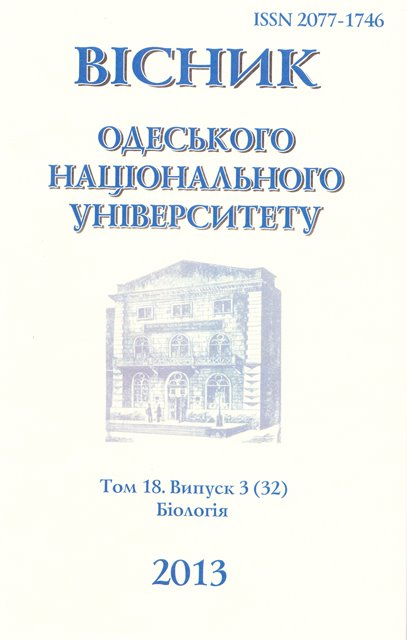ХАРАКТЕРИСТИКА СТРУКТУРИ КЕРАТИНОВИХ ВОЛОКОН РІЗНИХ ТИПІВ
DOI:
https://doi.org/10.18524/2077-1746.2013.3(32).45260Ключові слова:
кератини, матриксні, мікрофібрилярні протеїни, кутикула, високомолекулярні протеїни, кератози, амінокислотний складАнотація
Наведено результати порівняльного аналізу структурних характеристик кератинових волокон різної морфологічної будови. Встановлено відмінності в їх амінокислотному складі та співвідношенні протеїнових фракцій, які відповідають певним морфологічним компонентам волокна. Співвідношення між кристалічною та аморфною фазами волокон збільшується у ряді: волос людини - волос щура - вовна овець і становить відповідно 1,9; 2,1; 2,3.Посилання
Авторское свидетельство СССР № 702029. Способ разделения белков шерсти / В. В. Гуменюк, И. А. Макар. – Заявл. 10.05.1977; опубл. 05.12.1979; Бюлл. № 45. — 4 с.
Лабораторні методи досліджень у біології, тваринництві та ветеринарній медицині: довідник /В. В. Влізло, Р. С. Федорук, І. Б. Ратич та ін.; за ред. В. В. Влізла. — Львів: СПОЛОМ, 2012. – 764 с.
Морфологічні особливості шкіри та волоса різних видів тварин і людини в аспекті судово-ветеринарної експертизи / Коцюмбас Г. І., Коцюмбас І. Я., Щебентовська О. М. та ін. – Л.: ТзОВ ВФ “Афіша”, 2010. – 136 с.
Aoki N. Isolation and characterization of mouse high-glycine/tyrosine proteins / N. Aoki, K. Ito, M. Ito //J. of Biological Chemistry. – 1997. – Vol. 272, № 48. – P. 30512–30518. http://dx.doi.org/10.1074/jbc.272.48.30512
Asquith R. S. The morphological origin and reactions of some keratin fractures /R. S. Asquith, D. C. Parkinson // Textile Research Journal. – 1966. – Vol. 36. – P. 1064–1071. http://dx.doi.org/10.1177/004051756603601206
de Guzman R. C. Mechanical and biological properties of keratose biomaterials /R. C. de Guzman, M. R. Merrill, J. R. Richter et al. //Biomaterials. – 2011. – Vol. 32 (32). – P. 8205–8217. http://dx.doi.org/10.1016/j.biomaterials.2011.07.054
Fujii T. Convenient procedures for human hair protein films and properties of alkaline phosphatase incorporated in the film /T. Fujii, D. Ogiwara, M. Arimoto // Biol. Pharm. Bull. – 2004. – Vol. 27. – P. 89–93. http://dx.doi.org/10.1248/bpb.27.89
Gillespie J. M. The structural Proteins of Hair: Isolation, characterization, and regulation of biosynthesis / J. M. Gillespie // Physiology, biochemistry and molecular biology of skin: Oxford, 1991. – 658 p.
Kon R. Analysis of damaged components of permed hair using biochemical technique / R. Kon, A. Nakamura, N. Hirabayashi, K. Takeuchi // J. of Cosmetic Sciences. – 1998. – Vol. 49. – P. 13–22.
Rogers M. A. Human hair keratin-associated proteins (KAPs). / M. A. Rogers, L. Langbein, S. Praetzel-Wunder et al. // Intern. Rev. Cytol. – 2006. – Vol. 251. – P. 209–263. http://dx.doi.org/10.1016/s0074-7696(06)51006-x
Rouse J. A review of keratin-based biomaterials for biomedical application / J. G. Rouse, M. E. Van Dyke // Materials. – 2010. –Vol. 3. – P. 999–1014. http://dx.doi.org/10.3390/ma3020999
Schweizer J. New consensus nomenclature for mammalian keratins / J. Schweizer, P. E. Bowden, P. A. Coulombe et al. // J. Cell Biol. – 2006. – Vol. 174. – P. 169–174. http://dx.doi.org/10.1083/jcb.200603161
Sierpinski P. The use of keratin biomaterials derived from human hair for the promotion of rapid regeneration of peripheral nerves / P. Sierpinski, J. Garrett, P. Apel, D. Klorig, T. Smith, L. A. Koman, A. Atala, M. Van Dyke // Biomaterials. – 2008. – Vol. 29. – P. 118–128. http://dx.doi.org/10.1016/j.biomaterials.2007.08.023
Tachibana A. Fabrication of wool keratin sponge scaffolds for long-term cell cultivation / A. Tachibana, Y. Futura, H. Takeshima, T. Tanabe, K. Yamauchi // J. Biotechnol. – 2002. – Vol. 93. – P. 165–170. http://dx.doi.org/10.1016/s0168-1656(01)00395-9
Verma V. Preparation of scaffolds from human hair proteins for tissues-engineering application / V. Verma, P. Verma, P. Ray, A. R. Ray // Biomed. Materials. – 2008. – Vol. 3. – P. 25007. http://dx.doi.org/10.1088/1748-6041/3/2/025007
Sando L. Photochemical crosslinking of soluble wool keratins produces a mechanically stable biomaterial that supports cell adhesion and proliferation / L. Sando, M. Kim, M. L. Colgrave et al. // J. Biomed. Mater. Res. – 2010. – Vol. 95(3). – P. 901–911. http://dx.doi.org/10.1002/jbm.a.32913
Silk, mohair, cashmere and other luxury fibres / Ed. R. R. Franck – Woodhead publishing Ltd, 2001. – 255p. http://dx.doi.org/10.1201/9781439823095
##submission.downloads##
Опубліковано
Як цитувати
Номер
Розділ
Ліцензія

Ця робота ліцензується відповідно до Creative Commons Attribution-NonCommercial 4.0 International License.
Автори, які публікуються у цьому журналі, погоджуються з наступними умовами:
- Автори залишають за собою право на авторство своєї роботи та передають журналу право першої публікації цієї роботи на умовах ліцензії Attribution-NonCommercial 4.0 International (CC BY-NC 4.0).
- Автори мають право укладати самостійні додаткові угоди щодо неексклюзивного розповсюдження роботи у тому вигляді, в якому вона була опублікована цим журналом (наприклад, розміщувати роботу в електронному сховищі установи або публікувати у складі монографії), за умови збереження посилання на першу публікацію роботи у цьому журналі.
- Політика журналу дозволяє і заохочує розміщення авторами в мережі Інтернет (наприклад, у сховищах установ або на особистих веб-сайтах) роботи, оскільки це сприяє виникненню продуктивної наукової дискусії та позитивно позначається на оперативності та динаміці цитування опублікованої роботи (див. The Effect of Open Access).
Публікація праць в Журналі здійснюється на некомерційній основі. Комісійна плата за оформлення статті не стягується.

